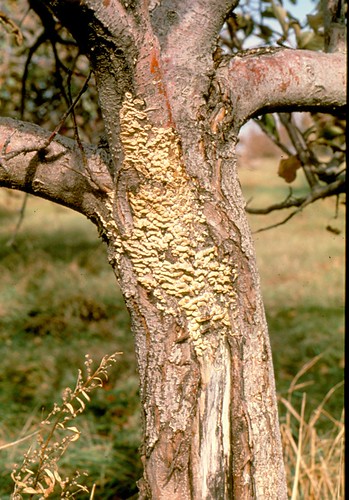Wood-rotting fungi cause losses over longer periods of time than most other apple diseases. Losses result mainly from breakage of branches and trunks due to a decline in the structural integrity of the wood. Fungal pathogens that colonize wood alter its structural integrity through enzymatic digestion of wood cell wall components. Some of the same fungi that cause wood rot can cause dieback as well.
The two most common symptoms of wood rot are the breakage of limbs or main trunk and the presence of fruiting bodies on the bark or wood surface (figs. 1, 2). However, fungi do not always produce fruiting bodies, and fruiting bodies occur less commonly on certain fruit tree species (for example, pear). Symptoms vary, depending on the particular wood-rotting fungus involved in the rot or dieback. For example, infection by Trametes versicolor causes a papery bark symptom in addition to wood rot. Symptoms usually are visible on the portions of large branches where the bark is still smooth. Where the outer bark separates from the inner bark, the bark has a tan to bronze-colored, blistery, paperlike quality. Smaller branches arise at the point where the limb is still healthy, and the infected part of the branch dies back to this point.
Wood-rotting fungi can cause dieback from the central leader, also. When this occurs, infected tissue appears water-soaked and darker than the surrounding tissue. As the infection progresses down the leader, branches are girdled, and the shoot tissues above the infection die completely.
Several fungi, including Trametes versicolor, Schizophyllum commune, Polyporus hirsutus, and Chondrostereum purpureum, cause wood rot. Wood-rotting fungi are opportunistic wound pathogens that colonize winter-injured or mechanically injured tissues. Where pruning is performed improperly, cut surfaces may remain wet for long periods of time, thus creating a favorable environment for wood-rotting fungi. Many wood-rotting fungi have broad host ranges, so orchards in the vicinity of wood lots or wooded fence rows may be at greater risk for infections than orchards in more open areas.
Manage your orchard to promote optimum winter hardiness. Balance tree nutrition. Avoid excessive fertilization with nitrogen and late-season irrigation. Also, avoid making horizontal pruning cuts to prevent water from accumulating and standing on the cut surfaces. In general, avoid making large cuts; at least, avoid making them late in the growing season and make them in such a way that the branch collar is preserved. The use of sealants or paints on pruning cut surfaces has not been proven to be beneficial and, therefore, is not recommended.
Web Resource
http://www.caf.wvu.edu/kearneysville/disease_descriptions/woodrot.html
Original text prepared by A. R. Biggs and K. S. Yoder


